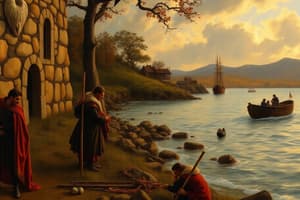Podcast
Questions and Answers
What event is commonly considered the beginning of the Viking Age?
What event is commonly considered the beginning of the Viking Age?
- The founding of Ladoga
- The settlement in Greenland
- The establishment of Danelaw
- The raid on Lindisfarne (correct)
Viking mapping relied heavily on advanced navigational tools.
Viking mapping relied heavily on advanced navigational tools.
False (B)
What term describes the accumulation of small changes leading to a large-scale transformation in societies?
What term describes the accumulation of small changes leading to a large-scale transformation in societies?
Singularity
The medieval trading town founded around AD 750 in today's Russia is known as ______.
The medieval trading town founded around AD 750 in today's Russia is known as ______.
Match the Viking Age topics with their descriptions:
Match the Viking Age topics with their descriptions:
What was one of the primary economic impacts of the Viking Age?
What was one of the primary economic impacts of the Viking Age?
The Viking Age was solely characterized by violent raids.
The Viking Age was solely characterized by violent raids.
Which geographical regions did Vikings primarily settle in during their expansion?
Which geographical regions did Vikings primarily settle in during their expansion?
What year did the Danish conquest of Anglo-Saxon kingdoms occur?
What year did the Danish conquest of Anglo-Saxon kingdoms occur?
Vikings primarily came to England to trade, not raid.
Vikings primarily came to England to trade, not raid.
What was one of the key features of the Viking raids on monasteries?
What was one of the key features of the Viking raids on monasteries?
The first phase of Viking history included raiding in the ______ Sea.
The first phase of Viking history included raiding in the ______ Sea.
Match the Viking features with their descriptions:
Match the Viking features with their descriptions:
Which of the following describes the term 'Maritoria' in the context of Viking raids?
Which of the following describes the term 'Maritoria' in the context of Viking raids?
Scandinavian armies began ______ in England by AD 850.
Scandinavian armies began ______ in England by AD 850.
What was the initial reaction of the English to Viking raids?
What was the initial reaction of the English to Viking raids?
Flashcards
Viking Age
Viking Age
A period of Scandinavian expansion and exploration, primarily from the late 8th to the 11th centuries, marked by raids, trade, and settlement.
Singularity (in systems theory)
Singularity (in systems theory)
A concept where small, cumulative changes lead to large-scale transformations and restructuring in complex systems.
Lindisfarne
Lindisfarne
An important location in northeastern England; considered by some the starting point of the Viking Age due to the 793 raid.
Viking Raids
Viking Raids
Signup and view all the flashcards
Ladoga
Ladoga
Signup and view all the flashcards
Viking Mapping
Viking Mapping
Signup and view all the flashcards
Economic Changes (Early Medieval)
Economic Changes (Early Medieval)
Signup and view all the flashcards
Danelaw
Danelaw
Signup and view all the flashcards
Viking Raids
Viking Raids
Signup and view all the flashcards
Viking Age Start
Viking Age Start
Signup and view all the flashcards
Lindisfarne
Lindisfarne
Signup and view all the flashcards
Viking Ships
Viking Ships
Signup and view all the flashcards
Political Economy
Political Economy
Signup and view all the flashcards
Ladoga
Ladoga
Signup and view all the flashcards
Sea Kings
Sea Kings
Signup and view all the flashcards
Monastic Attacks
Monastic Attacks
Signup and view all the flashcards
Study Notes
Maps
- Maps show Viking trading/raiding routes, homelands, and settlements.
- Modern political boundaries are shown for reference only.
- Viking maps used oral knowledge, environmental observations, and rudimentary navigational tools.
Singularity
- Concept captures small, cumulative changes leading to systemic transformation.
- Societies change through accumulation of events, not individual events.
- Minor shifts (trade routes, seafaring techniques, social norms) coalesce into large-scale societal restructuring.
- Viking Age emergence resulted from interconnected minor adjustments.
Lindisfarne (AD 793, NE England)
- Beginning of the Viking Age.
- Monastery in Northumbria (Anglo-Saxon kingdom in Northern England).
- Monks were killed or enslaved.
- Viking raids increased frequency on Britain, Ireland, and France.
- Scandinavian armies overwintered in England by AD 850.
- Danish conquest of Anglo-Saxon kingdoms in England by AD 870.
Salme Ship Burials (Estonia, ca. AD 750)
- Earlier example of a Viking raid to the east.
- 42 individuals buried in two Viking longships.
- Shield mound burial.
- Males killed in battle (trauma).
- DNA shows family relations.
- Ships embedded with arrowheads.
- Stable isotopes and artifacts indicate origin in central Sweden.
- Occurred 50-100 years earlier than the Lindisfarne raid.
- Possibly a failed raiding party or alliance attempt.
- Baltic Sea (not the Atlantic) was the initial phase of Viking history.
Documentary Accounts of Raids (Late 700s)
- Vikings came to raid, not trade.
- Surprise was that they came to raid.
- Religious dimension: Most of England was Christian, Vikings were "Seaborne pagans".
- Isolated, undefended, rich monasteries.
- Coastal monasteries in Scotland and Ireland were targets.
Maritoria: Viking Raids Part of Political Economy
- Political economy: Study of how economic systems and political systems are linked.
- Maritoria: New form of power combining aspirations of kings with control of territory and new markets.
- Linked by relations with the sea.
Economic Changes during Early Medieval Period (AD 476 – 1000)
- Warlord elites were at the end of the Roman Empire.
- Trade was initially localized.
- New market forces included the addition of long-distance trade leading to the establishment of trading towns.
- Trading towns became gateways to interior trading networks.
Ladoga
- Medieval trading town founded ca AD 750 in today's Russia.
- Ethnically mixed (Slavs, Scandinavians, Finns, Balts, Sami).
- Scandinavians dominated trade early.
- Later ethnically blended, melting pot.
- Frontier settlement.
- Raiding and trading were two components of the same phenomenon.
Sea Kings of Viking Age
- Critical to the beginnings of the Viking Age.
- Initially turned east (Baltic Sea) before turning west (North Sea).
- Vikings combined violent raiding with trading across ethnic lines.
Studying That Suits You
Use AI to generate personalized quizzes and flashcards to suit your learning preferences.




